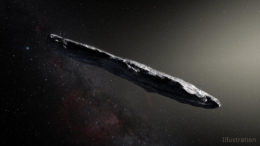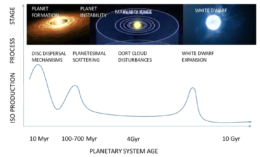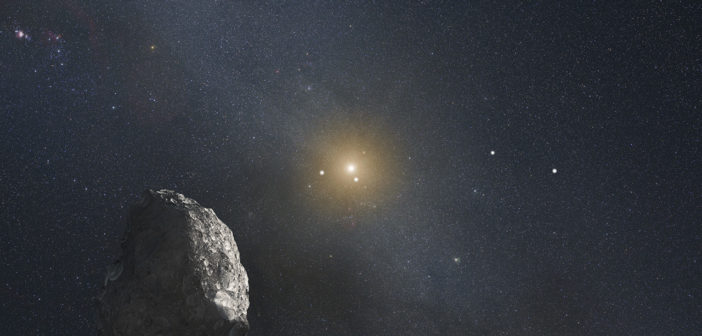When interstellar asteroid ‘Oumuamua sped through our solar system in 2017, it revealed that small bodies might make a habit of visiting other planetary systems. Could such objects occasionally be responsible for jump-starting planet formation?
Planet Formation in the Works

An artist’s impression of interstellar asteroid 1I/2017 U1 (‘Oumuamua). [European Southern Observatory / M. Kornmesser]
It’s also expected to take up to tens of millions of years to form a planet, which clashes with observations of planets forming in as little as a few hundred thousand years in disks that dissipate after just a few million years.
Many models of planet formation show that once planetesimals in a disk reach a certain size, they rapidly accrete gas to form planets. What if core accretion could get a head start from long-lost planetesimals ejected from other stellar systems?

A qualitative illustration of the timeline and mechanisms of interstellar object production. The times here are typical for a solar-mass star. Higher-mass stars would begin the final stage of interstellar object production earlier. Click to enlarge. [Pfalzner & Bannister 2019]
One System’s Trash, Another System’s Treasure?
To estimate how the population of interstellar objects affects the formation of new planets, Susanne Pfalzner (Jülich Supercomputing Center and Max Planck Institute for Radio Astronomy, Germany) and Michele Bannister (Queen’s University Belfast, UK) calculated the number of interstellar objects that survive the journey from their nascent star systems and become incorporated into new systems.
They began with an estimate of ‘Oumuamua-sized objects based on 30 years of observations from the Pan-STARRS1/Catalina Sky Survey: 1015 objects in a cubic parsec (about 35 cubic light-years).
The authors estimated that only a few percent of these objects can be easily captured by molecular clouds, and even fewer make it into the surroundings of a young star, which consumes all but 1–10% of the interstellar objects capable of acting as seeds for planet formation.
Plentiful Planetesimals

Density of 100-meter interstellar objects over the course of the star and planet formation process. [Pfalzner & Bannister 2019]
It’s not yet clear what role the abundant 100-meter objects play in planet formation, but simulations have shown that planetesimals larger than ~200 km rapidly accrete gas from their surroundings, forming both terrestrial and gas-giant planets in a blazingly fast 1,000 years.
Since the number of interstellar objects increases over time, the number of potential seeds for planet formation increases as well, meaning that planet formation is likely faster now than it was billions of years ago. There’s still plenty of work to be done, but one thing is clear: we can’t ignore the importance of interstellar objects in the planet formation process.
Citation
“A Hypothesis for the Rapid Formation of Planets,” S. Pfalzner & M. T. Bannister 2019 ApJL 874 L34. doi:10.3847/2041-8213/ab0fa0

2 Comments
Pingback: AAS Nova – New
Pingback: Daily Study Log (2019-04-13) | Study Astrophysics